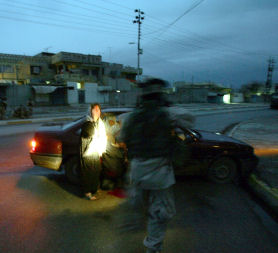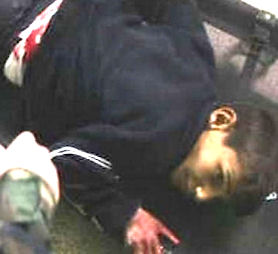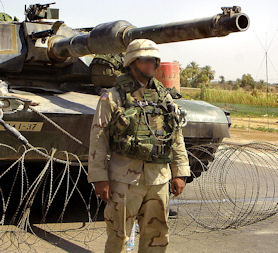Iraq war files: death at checkpoint
The secret files show that two-thirds of deaths 2004-09 were civilians and that significantly more ordinary people were killed at checkpoints than enemy fighters.

Channel 4 News has accessed the data in the classified documents via The Bureau of Investigative Journalism and WikiLeaks but has been unable to independently verify their authenticity.
Warning: You may find some of the details in this report disturbing.
Channel 4 News has analysed some of the “significant actions” outlined in the Iraq war logs made public by WikiLeaks. Despite the US claiming on a number of occasions that it did not “do body counts” of Iraqi civilians, the files reveal that they did.
The Bureau of Investigative Journalism (TBIJ) and Channel 4’s Dispatches created a purpose-built database to sift through the 400,000 files. Channel 4 News is the only British broadcaster with exclusive access to what they found.
In total the logs record 109,032 deaths and of these 66,081 are civilians, nearly two-thirds of all deaths logged by US troops in the six year period.
A further 176,000 civilians are also reported as wounded.
Until now these statistics have never been made public. A report in 2005 for US Congress titled “US Military and Iraqi Casualty Statistics: Additional Numbers and Explanations”, said: “The Department of Defense does not publicly release numbers on civilian deaths”.
Secret war files: Afghanistan to Iraq – special report
Statement from US Pentagon:
We deplore WikiLeaks for inducing individuals to break the law, leak classified documents and then cavalierly share that secret information with the world, including our enemies.
We know terrorist organizations have been mining the leaked Afghan documents for information to use against us and this Iraq leak is more than four times as large. By disclosing such sensitive information, WikiLeaks continues to put at risk the lives of our troops, their coalition partners and those Iraqis and Afghans working with us.
The only responsible course of action for WikiLeaks at this point is to return the stolen material and expunge it from their websites as soon as possible.

Former US President George W Bush and his administration insisted that the Pentagon did not keep civilian body counts. President Bush said in October 2003: “We have made a conscious effort not to be a body count team.
“Every day… I see who dies on our team. I don’t see who dies on their team.
“But… I think the judgment is right in the Pentagon not to be talking about the number we kill and capture on a weekly basis.”
Civilians were killed in Iraq between 2004 and 2009 in a number of ways. Chillingly, the war logs reveal civilians appeared to be killed in some circumstances while trying to surrender to coalition aircraft. Significant numbers of civilians were killed at coalition forces’ checkpoints and the files also reveal vulnerable civilians were used as suicide bombers by al-Qaeda.
Iraq secret files: the war in pictures
Hellfire air attacks
TBIJ and Dispatches found evidence within the Iraq war logs that civilians were killed by air attack. In some cases Iraqis, who may or may not have been insurgents, appeared to be killed from the air even as they tried to surrender to coalition forces.

Death at checkpoint
The Iraq war logs analysed by TBIJ and Dispatches reveal many civilians appeared to be killed at the hands of US forces when they approached military checkpoints in the road. These checkpoints were used in the hunt for insurgents by coalition forces. Troops carried out security checks on anyone moving through different areas of Baghdad and Iraq.
Under a special US rule of engagement for Iraq known as EOF “escalation of force”, any vehicle approaching a military checkpoint was required to slow down and stop to be searched. The TBIJ and Dispatches analysis reveals that between 2004 and 2009 a total of 834 people were killed in these escalation of force incidents. Of these some 80 per cent killed were civilians, totalling 681. There were a further 2,218 civilians wounded at checkpoints.
The records also reveal that over the six year period four times as many civilians were killed in escalation of force incidents than those listed as insurgents.
One incident was caught on camera by a photographer who was embedded with the First Brigade of the 25th Infantry Division in January 2005. The troops were in Tal Afar in northwest Iraq when they came across Camille and Hussein Hassan.
The children were not all unharmed. When the shots were fired, not only did the parents of these children die, but 11-year-old Rakan Hassan was also hit. His spine was pierced by a bullet, leaving him paralysed.
Translated from its original military code the war log says: “A Sedan sped toward the PTL (patrol) and failed to stop after visual signs were given.
“A shot was fired at the front tire but the VEH (vehicle) did not stop. The PTL engaged the VEH, killing 2X Civ (two civilians)”.
Both Camille and Hussein were shot dead, but they were not alone. There were six children sat in the back of the vehicle.
The translated war log says: “There were 6 x children in the back seat (all were unharmed).”
This final comment was inaccurate. The children were not “all” unharmed. When the shots were fired, not only did the parents of these children die, but 11-year-old Rakan Hassan was also hit.
His spine was pierced by a bullet, leaving him paralysed. His family was offered a total of $7,500 compensation by the US Army. This was calculated to compensate them for the loss of the two parents at $2,500 each and an extra $2,500 for damaging the car.
From TBIJ and Dispatches analysis it appears only 13 coalition troops were killed in similar escalation of force incidents. But the researchers also found that innocent civilians often appeared to be caught out by shots fired near checkpoints. Often these incidents were fatal.
The war logs suggest around 30 children were killed in these incidents. One entry says: “While crossing the street, patrol had an EOF (escalation of force) where patrol fired 3 rounds of M249 (light machine gun). One round ricocheted off the concrete hitting a 6yr old LN 250m down the road.”

Further down the report an update records: “##### Medical Facility reported to ##### that the 6yr old LN (##### ####### ######) died of wounds upon arrival at ####.”
Troops may often be fearful when a vehicle approaches a checkpoint, but there appears to be clear examples of them taking action before even finding out if there was a reason for the driver to be in a rush.
One such incident happened in 2007 when a doctor was killed as he tried to get a pregnant woman to hospital.
The war log says: “The gunner fired a warning shot from his M-4 down and away from the vehicle. The vehicle continued to approach and the gunner fired 2 x warning shots. When the vehicle did not stop the gunner fired 4 x disabling shots into the engine. The vehicle pulled over off the road.
Upon further evaluation the CIV had a suspicious satchel in his possession. The soldiers approached cautiously to look into the satchel to discover it contained books. Iraq war classified log
“An unconfirm report from ## #### ### reports that the driver, Dr. ##### ##### ######, was transporting a pregnant woman to the hospital and was shot by CF (coalition forces). The doctor, 1 x male, and 2 x females were taken to ## #### Hospital. The driver DOW (died of wounds).”
On other occasions soldiers appear to mistakenly think pedestrians were carrying suspicious items. In this entry a civilian is killed because he is carrying a satchel that appears to be “suspicious”.
In one war log the soldier writes: “###### reports that CIV (civilian) crawled through (2) sets of concertina wire towards the CP (checkpoint) in Baghdad. Soldiers at the CP fired (1) warning shot, which the approaching CIV ignored. The CIV continued to approach. The soldiers then fired (1) shot killing the CIV.
“Upon further evaluation the CIV had a suspicious satchel in his possession. The soldiers approached cautiously to look into the satchel to discover it contained books.”

Another report appears to reveal an innocent civilian was killed by troops at a checkpoint.
The log says: “##### signals with a laser and vehicle mounted spotlight; the vehicle abruptly halts and begins to travel in reverse at an accelerating rate.
“##### continues to shout and use visual signals to stop the car. Fires warning shots with smallest calibre weapon (5.56mm M4 rifles), and the car continues to evade.
“The patrol pursues the vehicle for a short distance firing an M2 MG into the ground in front of the vehicle and firing M4 into the engine block disabling the vehicle. Vehicle then continued to reverse and the following burst of M4 fire killed the driver.”
They would scrub our heads against the ground and they would beat me here and here, non stop beating and dragging. They would drag us from here and drag us there. Hussam Kareem and Kareem Wadee Abas
The report then says: “The driver of the vehicle Wadee Sidkin Al Kezin age 50 was killed by 5.56mm. The two passengers (Hussam Kareem Abas aged 17, Kareem Wadee Abas aged 21 were unharmed).”
TBIJ and Dispatches team found Hussam and Kareem in Iraq and asked them what they thought about the Iraq war log. They said: “No! No there was no signs or anything, no signs, no warning. They rammed our car, so we turned quickly and they started to shoot.”
The young men allege that following the death of Wadee the troops assaulted them.
They said: “They made us lay on the ground and they would bring their leg on our heads and they would scrub our heads against the ground and they would beat me here and here, non stop beating and dragging. They would drag us from here and drag us there.
“When the translator finally arrives he told us confess, aren’t you from the Mehdi Army? An we said we were not form the army or anything, we were heading off to work”.
However, the military war log gives a different version of events. In the report it says: “##### respectfully transported the vehicle and the deceased to the family’s house IOT (in order to) allow them to begin funeral preparations. ##### arrived on site with TPT and conducted consequence management. CF (coalition forces) will remain in contact with the family involved in the incident and will be preparing a condolence packet.”
Vulnerable civilians used by al-Qaeda
The analysis carried out by TBIJ and Dispatches reveals that on average around 30 improvised explosive devices (IEDs) were being detonated every day over the six years in Iraq.
Many of these devices were carried by suicide bombers, but the Iraq war logs reveal some of these suicide bombers appear to be innocent vulnerable civilians.
In one incident in March 2007 it is revealed a teenage boy was used as a suicide bomber. In the war log the US soldier writes: “A 12-14 year old boy wearing a back pack and on a bicycle rode into the intersection. The patrol passed through the intersection and the boy detonated his explosives targeting the passing vehicles”.
Another incident, almost a year later in February 2008 a war log reveals disabled Iraqi civilians were also being used by insurgents.
In the war log it states: “#### takes young LN (Local National) to his house, and talked to the LN’s uncle and mother. The boy’s age is 13 years old. They say the boy is mentally handicapped.
“S2 (military intelligence) assessment: recent reports indicated in Iraq> AQI (al Qaeda in Iraq) is recruiting young local nationals and also using mentally handicapped persons to target CF (Coalition Forces) within the dragoon OE (operational environment).”